In his 1944 semi-autobiographical "Return to Tsugaru," Japanese author Osamu Dazai (1909-48) revisits his native Tsugaru, a peninsula in northernmost Aomori Prefecture and, apart from praising its people, has mostly unflattering things to say about the place. Forty years later, British writer Alan Booth followed in his footsteps, walking the entire peninsula to the mouth of the then recently finished Seikan Tunnel that connects Honshu and Hokkaido. Booth's observations largely echo those of Dazai.
On own my journey to Tsugaru, I decide to take the train, as it is still freezing in late March and also because the train sets itself apart in two curious ways: first, it has a coal stove used to thaw frozen passengers; and second, you can grill squid on that same stove. Need I mention the sake to wash it down? In other words, it sounds like the perfect place to get acquainted with a genuine Tsugarian or two.
I make my way on local lines to the city of Goshogawara, where the diesel-powered stove train is ready to depart for Nakazato, a distance of roughly 20 kilometers. As I step onto the platform, I feel as if I've been teleported to prewar Japan and before boarding the rustic train, a woman greets me, followed by a conductor with a thick Tsugaru accent. They have a certain aura about them, and I begin to understand what Dazai and Booth were talking about.



















With your current subscription plan you can comment on stories. However, before writing your first comment, please create a display name in the Profile section of your subscriber account page.